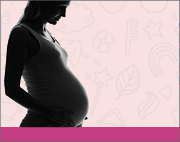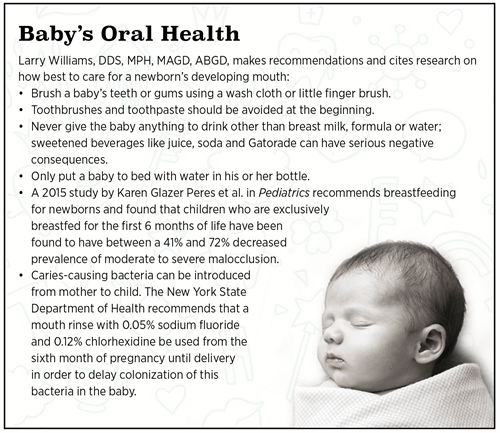Caring for Two: How to Treat Pregnant and Breastfeeding Patients
This is a Self-Instruction article worth 1 CE credit. The exercise can be purchased and answers submitted at agd.org/self-instruction.
 During pregnancy, women undergo changes in their cardiovascular, hematologic, respiratory, gastrointestinal, genitourinary, endocrine and orofacial systems. Any treatment provided by a dentist can have serious consequences to the woman and her unborn child.1
During pregnancy, women undergo changes in their cardiovascular, hematologic, respiratory, gastrointestinal, genitourinary, endocrine and orofacial systems. Any treatment provided by a dentist can have serious consequences to the woman and her unborn child.1
Due to these concerns, dentists may be cautious about providing treatment to pregnant and breastfeeding women. They should be aware of many unique treatment considerations for pregnant or breastfeeding women, such as radiation concerns, medication safety and timing treatment with patients’ trimesters.
“Empathy at the beginning is extremely important. You should be supportive and encouraging,” said Larry N. Williams, DDS, MPH, MAGD, ABGD, associate professor of dental medicine at the Midwestern University College of Dental Medicine. “Talk to your patients upfront about what pregnancy means for their dental care.”
Drug Concerns
While many drugs commonly used in dentistry are safe for pregnant and breastfeeding mothers, dentists should minimize or avoid certain medications completely. Many antibiotics such as clindamycin, penicillin, metronidazole, cephalosporins and amoxicillin are generally recognized as safe. However, certain drugs, such as chloramphenicol, could lead to maternal toxicity and fetal death.1 For analgesics, acetaminophen, morphine and meperidine are generally recognized as safe, while oxycodone and hydrocodone should be avoided. Aspirin, ibuprofen and naproxen are contraindicated during the third trimester and during breastfeeding.1
In 2015, the Food and Drug Administration released new communication standards for medications prescribed to pregnant and nursing women. While over-the-counter medicines were not impacted, the new standards had a major effect on how dentists understood the safety and prescription of many drugs. The new Pregnancy and Lactation Labeling Rule (PLLR) did away with the pregnancy letter categories — A, B, C, D and X — and instead now mandates descriptive narratives that provide more information.
“I didn’t realize that I was incorrectly using the pregnancy risk categories,” said Daniel Ninan, DDS, author of “Dentistry and the Pregnant Patient.” With the previous risk assessment letters, Ninan would identify drugs closest to being in category A to fit his patients’ treatment needs. “With this new system, the information is reorganized and presented in more detail, which will allow for a more involved discussion between the physician and the patient about risks and clinical considerations during conception, pregnancy and the postpartum stage.”
The PLLR also expanded the scope of the labeling program. Instead of only covering pregnant women and new mothers, the PLLR includes a new patient category — Females and Males of Reproductive Potential.2 The section includes whether pregnancy testing is needed, contraception recommendations and information about infertility as it relates to the drugs.2
“When considering prescribing during pregnancy, the dentist must weigh the risk to the fetus versus the benefit to the mother, and the appropriate conclusion should reflect current evidence,” wrote Mark Donaldson, PharmD, FASHP, FACHE, associate principal, pharmacy advisory solutions, at Vizient, in an article in the Journal of the American Dental Association in 2012.3
Radiography
While radiography generally presents few complications for pregnant women, there are several details dentists should know. The American College of Radiology and the American College of Obstetricians and Gynecologists have both said that a single diagnostic radiograph does not provide enough radiation to cause any harm to an embryo or fetus.4,5 The American Dental Association (ADA) recommends patients wear a lead apron to protect both the thyroid and the abdominal area.6
Radiation doses of 5 grays in the first trimester and 10 Gy in the second and third trimesters may cause fetal deformities. The estimated dose to the mother in a full-mouth radiograph or CT scan of the back of the head and neck is 0.002% of that risk.1
“I am cautious about saying radiographs are safe,” Ninan said. “Dental radiographs are a form of ionizing radiation, which carries a very small risk of radiation-induced cancer or a radiation burn. Because there is potential risk with dental radiographs, the ADA and FDA have created recommendations for when radiographs should be taken.”
The ADA recommends dentists conduct a clinical examination, review the patient’s oral and medical history, as well as review the patient’s responses to environmental factors that could impact oral health, before the dentist takes any radiographs.7 The type of imaging, frequency and number of images taken are all impacted by what that diagnostic review reveals.7 Dentists should continue to follow these guidelines during a patient’s pregnancy and take select radiographs when needed for immediate treatment.6
Safety for pregnant dental staff members should also be taken seriously, especially because staff members experience repeated and regular exposure. “For staff members who are pregnant, you have to be concerned. You have to make sure you’re wearing your radiation monitoring badge,” Williams said.
Radiation monitoring badges are personal dosimeters that measure the amount of ionizing radiation to which the wearer is exposed.
Purchase radiation monitoring badges for yourself or your staff through the AGDVANTAGE program at agd.org/agdvantage.
Anesthesia and Sedation
Local anesthesia can be safe for pregnant and breastfeeding patients, while general anesthesia is not recommended for pregnant patients unless there is an emergency. Spontaneous abortions have been attributed to nitrous oxide, while cleft lip and palate have been attributed to benzodiazepines, which are also excreted into breast milk.1
“I would prefer that my patients never be exposed to nitrous oxide during pregnancy,” Williams said. “When there’s a risk of fetal harm, it’s recommended that patients and staff avoid it.”
Local anesthetics, while safer, do carry risks. Ninan recommends reducing the maximum dose to reflect the toxicity of local anesthetics and says lidocaine is the “anesthetic of choice.”
“Many local anesthetics with or without epinephrine are considered safe for use as well as many antibiotics,” said Donaldson. “Use of other medications calls for consultation with the patient’s obstetrician to weigh risks and benefits. An example of a situation that may benefit from consultation is pain relief.”

Systemic Implications
Periodontal disease is widespread, affecting nearly half of the general population.8 Additionally, 30% of pregnant women will experience pregnancy gingivitis.9 According to Ninan, adverse outcomes due to periodontal disease in pregnancy include low birth weight, preterm birth, small size for gestational age, pregnancy-induced hypertension, and fetal loss. According to one study, the presence of periodontal disease in a pregnant woman results in a 7.5 times greater risk of a preterm, low birth–weight infant.10 In one tragic case, subgingival bacteria traveled to the placenta and was implicated in a term stillbirth.11
“Preventive, diagnostic and restorative dental treatment is safe throughout pregnancy,” Donaldson said. “Every pregnant woman should be screened for oral risks, counseled on proper oral hygiene, and referred for dental treatment when necessary. Dental procedures such as diagnostic radiography, periodontal treatment, restorations and extractions are safe and best performed during the second trimester.”
Responding to the pregnant patient’s current health situation is one consideration, while anticipating future health problems is another. Two-thirds of women experience nausea and vomiting, while heartburn occurs in 30%–50% of pregnant women, both of which directly impact dental health by way of acid damage to tooth enamel.1
"Dental procedures such as diagnostic radiography, periodontal treatment, restorations and extractions are safe and best performed during the second trimester."
Mark Donaldson, PharmD, FASHP, FACHE
“You have to talk about oral hygiene, changes in diet and the impact of morning sickness,” Williams said. “I recommend that she brushes twice per day for two minutes and continue flossing. If she has morning sickness, she can use a fluoride rinse right after she throws up, but she shouldn’t brush her teeth for at least 30 minutes after — if she brushes too soon, she will be brushing the acid into the enamel, and it will damage the enamel.”
The number of births may also affect a woman’s number of teeth. A few studies have found an association between the number of children a woman has and the number of teeth she has lost. A 2018 study in Europe found that, after having two consecutive children of the same sex, women who had a third child were missing around four more teeth than women who had just two children of different sexes.12 A 2005 study at New York University found that as a woman’s number of children increased, so did her chances of suffering from dental maladies.13 This could be due to a number a reasons, from lack of time to attend to oral health to a greater tendency to eat junk food. The significance of the findings emphasizes the importance of proper oral hygiene and supportive dental treatment during pregnancy.
Dentists have a responsibility to talk with their patients and treat the unique oral health concerns present during pregnancy. Many factors come into play during this time, and, as healthcare providers, dentists must work hard to maintain the oral health of mothers and the safety of their children.
Dan Kolen is a freelance writer and media producer based in Chicago. To comment on this article, email impact@agd.org.
References
- Kurien, Sophia, et al. “Management of Pregnant Patient in Dentistry.” Journal of International Oral Health, vol. 5, no. 1, Feb. 2013, pp. 88-97.
- Lal, Renu. “Drugs in Pregnancy and Lactation: Improved Benefit-Risk Information.” FDA/CDER SBIA Chronicles, www.fda.gov/media/90642/download. Jan. 22, 2015.
- Donaldson, Mark, and Jason H. Goodchild. “Pregnancy, breast-feeding and drugs used in dentistry.” Journal of the American Dental Association, vol. 132, no. 8, Aug. 2012, pp 858-871. Erratum in vol. 143, no. 11, Nov. 2012, p. 1187.
- “ACR–SPR Practice Parameter for Imaging Pregnant or Potentially Pregnant Adolescents and Women with Ionizing Radiation.” American College of Radiology, 2018, www.acr.org/-/media/ACR/Files/Practice-Parameters/pregnant-pts.pdf. Accessed 12 Nov. 2019.
- American College of Obstetricians and Gynecologists. “Oral health care during pregnancy and through the lifespan. Committee Opinion No. 569.” Obstetrics & Gynecology, vol. 122, 2013, pp. 417-422. www.acog.org/Clinical-Guidance-and-Publications/Committee-Opinions/Committee-on-Health-Care-for-Underserved-Women/Oral-Health-Care-During-Pregnancy-and-Through-the-Lifespan? Accessed 12 Nov. 2019
- Ninan, Daniel. Dentistry and the Pregnant Patient. Quintessence, 2018.
- American Dental Association Council on Scientific Affairs, U.S. Department of Health and Human Services Public Health Service Food and Drug Administration. “Dental Radiographic Examinations: Recommendations for Patient Selection and Limiting Radiation Exposure.” American Dental Association, 2012, www.ada.org/~/media/ADA/Member%20Center/FIles/Dental_Radiographic_Examinations_2012.pdf. Accessed 12 Nov. 2019.
- Eke, P.I., et al. “Prevalence of Periodontitis in Adults in the United States: 2009 and 2010.” Journal of Dental Research, vol. 91, no. 10, 2012, pp. 914-920.
- Kumar, Jayanth, and Renee Samelson, eds. Oral health care during pregnancy and early childhood: practice guidelines. New York State Department of Health, 2006, www.health.state.ny.us/publications/0824.pdf. Accessed 12 Nov. 2019.
- Kane, Shawn F. “The effects of oral health on systemic health. General Dentistry, vol. 65, no. 6, 2017, pp. 30-34.
- Han, Yiping W., et al. “Term Stillbirth Caused by Oral Fusobacterium nucleatum.” Obstetrics & Gynecology, vol. 115, no. 2, part 2, 2010, pp. 442-445.
- Gabel, Frank, et al. “Gain a child, lose a tooth? Using natural experiments to distinguish between fact and fiction.” Journal of Epidemiology & Community Health, vol. 6, no. 72, 2018, pp. 552-556.
- O’Connor, Anahad. “The Claim: Gain a Child, Lose a Tooth.” The New York Times, 24 April 2007, www.nytimes.com/2007/04/24/health/24real.html. Accessed 14 Nov. 2019.
